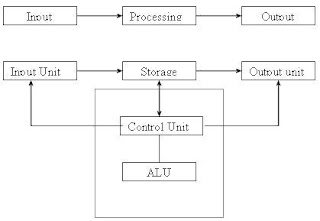A central processing unit (CPU) is the electronic circuitry within a computer that carries out the instructions of a computer program by performing the basic arithmetic, logical, control and input/output (I/O) operations specified by the instructions. The term has been used in the computer industry at least since the early 1960s. Traditionally, the term "CPU" refers to a processor, more specifically to its processing unit and control unit (CU), distinguishing these core elements of a computer from external components such as main memory and I/O circuitry.
Alternatively referred to as the brain of the computer, processor, central processor, or microprocessor, the CPU (pronounced as C-P-U), short for Central Processing Unit, was first developed at Intel with the help of Ted Hoff in the early 1970's. The computer CPU is responsible for handling all instructions it receives from hardware and software running on the computer.
Its size affects speed, power and capability. Primary memory and secondary memory are two types of memories in the computer. Functions of memory unit are:
· It stores all the data and the instructions required for processing.
· It stores intermediate results of processing.
· It stores final results of processing before these results are released to an output device.
· All inputs and outputs are transmitted through main memory.
Functions of this unit are:
· It is responsible for controlling the transfer of data and instructions among other units of a computer.
· It manages and coordinates all the units of the computer.
· It obtains the instructions from the memory, interprets them, and directs the operation of the computer.
· It communicates with Input/Output devices for transfer of data or results from storage.
· It does not process or store data.
Arithmetic section
Logic Section
Function of logic section is to perform logic operations such as comparing, selecting, matching and merging of data.
Memory or Storage Unit
This unit can store instructions, data and intermediate results. This unit supplies information to the other units of the computer when needed. It is also known as internal storage unit or main memory or primary storage or Random access memory(RAM).Its size affects speed, power and capability. Primary memory and secondary memory are two types of memories in the computer. Functions of memory unit are:
· It stores all the data and the instructions required for processing.
· It stores intermediate results of processing.
· It stores final results of processing before these results are released to an output device.
· All inputs and outputs are transmitted through main memory.
Control Unit
This unit controls the operations of all parts of computer but does not carry out any actual data processing operations.Functions of this unit are:
· It is responsible for controlling the transfer of data and instructions among other units of a computer.
· It manages and coordinates all the units of the computer.
· It obtains the instructions from the memory, interprets them, and directs the operation of the computer.
· It communicates with Input/Output devices for transfer of data or results from storage.
· It does not process or store data.
ALU(Arithmetic Logic Unit)
This unit consists of two subsections namelyArithmetic section
Logic Section
Arithmetic Section
Function of arithmetic section is to perform arithmetic operations like addition, subtraction, multiplication and division. All complex operations are done by making repetitive use of above operations.Logic Section
Function of logic section is to perform logic operations such as comparing, selecting, matching and merging of data.




No comments:
Post a Comment